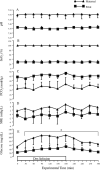Maternal and preterm fetal sheep responses to dexmedetomidine
- PMID: 22938943
- PMCID: PMC3462238
- DOI: 10.1016/j.ijoa.2012.06.010
Maternal and preterm fetal sheep responses to dexmedetomidine
Abstract
Background: The α(2) adrenergic receptor agonist dexmedetomidine has some unique pharmacologic properties that could benefit pregnant patients (and their fetuses) when they require sedation, analgesia, and/or anesthesia during pregnancy. The purpose of the present study was to delineate maternal and fetal responses to an intravenous infusion of dexmedetomidine.
Methods: This study was conducted on surgically-recovered preterm sheep instrumented for physiologic recording and blood sampling. Maternal and fetal cardiovascular and blood gas parameters and fetal cerebral oxygenation levels were recorded before, during, and after 3h of dexmedetomidine infusion to the ewe at a rate of 1 μg/kg/h.
Results: Drug infusion produced overt sedation but no apparent respiratory depression as evidenced by stable maternal arterial blood gases; fetal blood gases were also stable. The one blood parameter to change was serum glucose, By the end of the 3-h infusion, glucose increased from 49±10 to 104±33mg/dL in the ewe and from 22±3 to 48±16mg/dL in the fetus; it declined post-drug exposure but remained elevated compared to the starting levels (maternal, 63±12mg/dL, P=0.0497; and fetal, 24±4mg/dL, P=0.012). With respect to cardiovascular status, dexmedetomidine produced a decrease in maternal blood pressure and heart rate with fluctuations in uterine blood flow but had no discernable effect on fetal heart rate or mean arterial pressure. Likewise, maternal drug infusion had no effect on fetal cerebral oxygenation, as measured by in utero near-infrared spectroscopy.
Conclusions: Using a clinically-relevant dosing regimen, intravenous infusion of dexmedetomidine produced significant maternal sedation without altering fetal physiologic status. Results from this initial acute assessment support the conduct of further studies to determine if dexmedetomidine has clinical utility for sedation and pain control during pregnancy.
Copyright © 2012 Elsevier Ltd. All rights reserved.
Figures




References
-
- Reynolds JD, Booth JV, de la Fuente S, et al. A review of laparoscopy for non-obstetric-related surgery during pregnancy. Curr Surg. 2003;60:164–73. - PubMed
-
- Augustin G, Majerovic M. Non-obstetrical acute abdomen during pregnancy. Eur J Obstet Gynecol Reprod Biol. 2007;131:4–12. - PubMed
-
- Parangi S, Levine D, Henry A, Isakovich N, Pories S. Surgical gastrointestinal disorders during pregnancy. Am J Surg. 2007;193:223–32. - PubMed
-
- Gjelsteen AC, Ching BH, Meyermann MW, et al. CT, MRI, PET, PET/CT, and ultrasound in the evaluation of obstetric and gynecologic patients. Surg Clin North Am. 2008;88:361–90. vii. - PubMed
-
- Dietrich CS, 3rd, Hill CC, Hueman M. Surgical diseases presenting in pregnancy. Surg Clin North Am. 2008;88:403–19. vii–viii. - PubMed
Publication types
MeSH terms
Substances
Grants and funding
LinkOut - more resources
Full Text Sources

